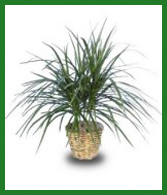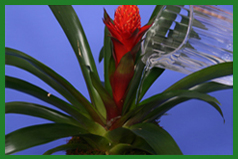 |
| red-margined dracaena (Dracaena marginata) |
If you’re looking for a house plant that makes a bold statement indoors, consider a member of the Dracaena family or a specimen from the Bromeliad tribe. Being tropical in origin, plants in either group are well-adapted to our interior environments, and each of them has its own unique character that can command attention as a decorative accent to almost any room. Bromeliads are mostly small to medium-sized plants that are comfortable in a 6″ or 8″ pot, relying on their long-lasting, colorful blooms and interesting patterned foliage to make an impression. Many dracaenas, however, can reach tree-like proportions, achieving the status of living, indoor sculpture.
 |
| red-margined dracaena (Dracaena marginata) |
The name ‘dracaena’ comes from a Greek word meaning ‘female dragon’, perhaps in reference to the sharply spiked foliage of some of the species. Dracaenas are among the most durable of houseplants, and are tolerant of a wide range of growing conditions. Many forms exist, but nearly all dracaenas are characterized by having linear foliage that grows in a whorl from the stem. One well-known variety of dracaena is the so-called ‘corn plant’ (Dracaena massangeana fragrans), which bears relatively broad, floppy, green leaves with longitudinal yellow stripes. Corn plant dracaenas are often sold as tall, potted, woody ‘canes’ with fountains of foliage sprouting from their tops. The large ones — sometimes six feet or more in height — create a striking presence in any interior space.
Another popular variety is the red-margined dracaena (Dracaena marginata). This one has long, narrow, pointed, dark green leaves with thin red margins at the edges. As the plant grows, the lower leaves are gradually lost as new ones emerge from the top, eventually resulting in a slender, ridged, grayish stem with a tuft of foliage at the top. When several of these dracaenas are potted together, the stems can exhibit a very sculptural appearance. In fact, commercial nurseries sometimes grow Dracaena marginata plants lying on their sides for long periods at a time, rotating the pots every so often, which causes the stems to curve and grow upward, giving the plant an artistic character.
The striped dracaena, Dracaena deremensis ‘Warneckei’, is another favorite species. The leaves are wider than those of the red-margined dracaena, and normally have narrow white lines running the length of each dark green, pointed blade. In the cultivar ‘Lemon Lime’, the narrow white lines are replaced by broad, chartreuse stripes. Dramatic indeed! Striped dracaenas are typically grown as bushy shrubs, owing to the plant’s tendency to retain its lower leaves as it slowly grows taller. They are a good choice for filling a bare interior corner.
Dracaenas will survive a long time in a fairly shaded environment, but they will look their best and their leaf color will be brighter if they are given a bit more light. Allow the soil in a dracaena plant’s pot to become somewhat dry between thorough waterings. A dracaena growing in dim light will require less water than one in a bright location. Fertilize monthly spring and summer with a balanced house plant food, mixed at one-half the recommended dilution. Dracaenas can sometimes develop brown edges along their leaves. This may be caused by any number of situations, including dry air, allowing the soil to become too dry, a buildup of fertilizer salts in the soil, or heavily chlorinated or fluoridated water. Regular dusting of the leaves is important and misting with water is also beneficial. See our prior newsletter “House Plants For Interiors” for more care instructions.
Bromeliads comprise a large class of tropical plants that occur in many different forms. But the one characteristic that unites nearly all of the bromeliad family is the fact that, in nature, they live in the trees. Botanically, plants that grow like this are known as ‘epiphytes’. Bromeliads, like all epiphytes, use the tree branches to support them up in the brighter light and the fresh, moving air that isn’t available on the forest floor. They do not hurt the host plants or draw any nourishment directly from them. Instead, most bromeliads are able to collect rainwater in their center ‘vases’. They also accumulate plant debris and animal wastes that happen to fall in, which gradually decompose and nourish the plants. Epiphytic bromeliads are an important part of tropical ecosystems. Larger ones, sometimes called ‘tank bromeliads’ hold enough water in their centers to support many forms of life, providing a drink to a thirsty bird and allowing frogs and insects to complete their entire life cycles within their leaves.
Fortunately, many bromeliads (pronounced “bro-MILL-ee-ad”) are durable and dramatic houseplants. One commonly available bromeliad is called ‘Silver Vase’ (Aechmea fasciata). Its leaves are a silvery-gray in color and patterned in dusty silver markings that give it a shimmering appearance. It produces an exotic-looking, spikey, pink inflorescence from the center. But beware; the leaves are edged with sharp spines. Another favorite kind is the ‘Flaming Sword’ bromeliad (Vriesea splendens), with rigid, strap-like leaves marked in irregular horizontal bands of dark green and black, and blooming with a bright orange, spear-shaped spike from which vivid yellow flowers emerge. Many other species exist, but the most well-known bromeliad of all, the pineapple, is also among the most unusual in that it is terrestrial (lives on the ground) and it produces edible fruit.
Dracaenas and Bromeliads: Striking Houseplants for Interior Spaces
proper bromeliad watering
 |
| proper bromeliad watering |
The distressing truth about bromeliads is that the individual plant very slowly begins to die after flowering and nothing can be done to stop it. However, before it goes, it replaces itself with one or more pups, or offsets, that may be separated from the mother plant and grown independently until they themselves bloom. Because they derive most of their moisture from their centers, the bromeliad ‘vase’ must be kept full of water. You may even put a very small amount of dilute fertilizer into the center vase every so often. Bromeliads are usually potted in a coarse, barky mixture that drains fairly rapidly. Keep the potting medium moist, but not saturated. The light requirements of bromeliads vary; the ‘Silver Vase’ prefers a very bright location, but out of direct sun. The ‘Flaming Sword’ can tolerate more shade.
Visit our Gallery of House Plants to see pictures of more dracaenas and other plants. Contact your local professional florist about these and other varieties of bromeliads and dracaenas that may be suitable for your growing conditions, and bring a touch of the tropical into your home or office. Or, have a plant sent to someone else as a token of appreciation or affection. The fresh, visual appeal of any of these living works of sculptural art is sure to delight anyone who sees them.
For more interest articles read
House Plant Propagation
Orchid and Orchid Care.
Ficus and Philodendron: Favorite House Plants for Fathers Day.
African Violets for One & All.
Favorite herbs – Basil, Rosemary, Mint and Oregano.
The Art of Bonsai.
Caring for Your Peace Lily.
Caring for Your Azalea.
Caring for Your Lucky Bamboo.
Houseplant Identification.
Houseplant Chase away the Winter Blues.


 Find Your
Find Your 
Speak Your Mind